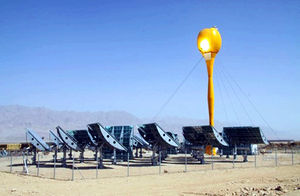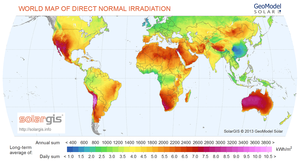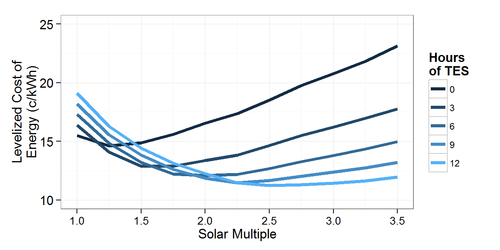Knowledge fuels change
For over a decade, Energypedia has shared free, reliable energy expertise with the world.
We’re now facing a serious funding gap.
Help keep this platform alive — your donation, big or small, truly matters!
Thank you for your support
Concentrating Solar Power (CSP) - Basics and Introduction
Overview
| Concentrating Solar Power (CSP) is a type of renewable energy (RE) that uses the sun's energy to generate electricity and process heat. CSP plants can also be used for desalinization and Solar Fuels applications. Most applications are large-scale. Solar Thermal Power Plants are large scale renewable energy infrastructures using heat produced by contracted solar beams (Concentrated Solar Power (CSP)). Mirrors concentrate solar beam on a receiver. The produced heat with temperatures of 400ºC to 1000ºC can be used directly, be transformed into electricity or stored. |
|
CSP Systems are replacing fossil fuels with CO2-emission free energy and therefore reduce the overall greenhouse gas emissions. According to Greenpeace the energy pay back time of an CSP plant can amount to just 5 months depending on its configuration and size.[1] CSP Plants can remain in operation for almost 40 years and thus demonstrate its durability and reliability.
Solar Resource
The favourable regions to apply CSP Technology are open for discussion. However, a good indicator to identify CSP potentials is the direct normal irradiation (DNI). Maps can show the distribution of DNI all over the world and thus give a first clue as to where CSP power plants should be built.
Mainly the MENA region, western USA, Southern Africa, Australia and parts of South America.
Generation Costs
Generation costs are currently at reasonable levels and still dropping. They range from 150 US-$/ MWh to 200 US-$/ MWh.[2] The diagram below is taken from the report of the NREL. Hours of TES meaning the thermal storage capacity of the power plant: the time measured in hours that the given power plant can run at rated power output with the storage as its only energy source. The Solar Multiple describes the relation of the installed solar power to the power of the motor block. An over-sized power plant (SM > 1) produces more energy at full solar power intake than the motor can transform. It therefore needs storage facilities to divert the power surplus; otherwise the energy gets spilled.
The SunShot Initiative Concentrating Solar Power Research and Development is trying to reach generation costs of 60 US-$/ MWh by addressing technical barriers for solar fields, receivers and power plants.[3] For more information on levelized cost of energy/ generation costs also see the Cost Analysis of the International Renewable Energy Agency.
Environmental Impacts
According to investigations done by the European Academies Science Advisory Board Concentrating Solar Power plants potentially impact the environment in the following ways:
- Atmospheric pollution from fuel combustion (in hybrid operation) and during production and construction of equipment (lifecycle emissions)
- Impacts on flora and fauna
- Water consumption
- Land use and visual impact
- Consumption of energy and materials
- Noise of cooling towers when applying air or evaporation cooling
- Smell and potential pollution of soil and water and fire hazard for systems using synthetic oil heat transfer fluid, which is considered a hazardous material.[4][5]
The environmental impact of CSP is greatly reduced compared to fossil-fuel-based sources, with the main reason being the reduced carbon dioxide emissions resulting from the substitution of fuel with sunlight as an energy source.
CSP systems typically use steam turbines to produce mechanical power which is then converted to electricity. As a result, there are similar issues around noise and visual amenity if they are located overly close to built-up areas.
In some cases, CSP systems are provided with fossil fuel backup, allowing electricity production for a larger number of hours per day. In such cases, the environmental impacts of normal fossil-fuel based electricity production apply, proportionally to the amount of time that the backup is used. However there are also numerous examples of large CSP systems which have no fossil fuel backup, such as the Crescent Dunes system in Tonopah, USA.
Water use in CSP systems depends heavily on whether or not dry cooling is used in the power block. If so, CSP water use is comparable with that of a coal power plant. If not, CSP water use is comparable with a photovoltaic power plant, where water is used primarily for mirror cleaning together with a small amount of steam blow-down. Increasingly, dry (air) cooling is being used in CSP systems due to the high cost of water in arid/desert areas.
Parabolic trough systems typically make use of a synthetic oil as the heat transfer fluid which circulates through the field. There is a risk that this oil can leak, and enter the soil, and is also flammable[6]. These risks can be minimised through standard inspection and maintenance activities.
CSP systems are large, and in particular, central tower systems can be visible from a long distance. The glint and glare of reflected light from CSP systems, as with PV systems, needs to be considered if locating CSP systems close to airports or flight paths.
Birds have been reported to have been killed when flying through the focussed beam of CSP systems, and this has been the topic of recent research. However it appears that suitable operating strategies (in particular, the way in which mirrors are pointed when they are not being used to produce heat) can greatly reduce this problem.
CSP systems occupy relatively large areas of usually arid/desert land. In some cases, rare flora and fauna exist in these locations and conservation action needs to be considered.
CSP systems are constructed largely from steel, concrete and glass. These materials are stable in the environment and relatively non-toxic. However the embodied energy of these materials must be considered in assessing the environmental impact.
A recent meta-study of lifecycle analysis for CSP estimated that including building materials, the greenhouse gas emissions (carbon dioxide equivalent) from CSP electricity is 26 g/kWh of electricity[7]. This means that the overall environmental impact from CSP is very similar to that of other renewable energy sources.
Further Information
- Solar Portal on energypedia
- Concentrating Solar Power (CSP) - Technology
- Concentrating Solar Power (CSP) - Planning
- For a short introduction to Concentrating Solar Power, the idea behind and the general plant design as well as its benefits and obstacles, please feel free to watch the video provided by SolarReserve:
- Current Project Structures and Financing Opportunities for CSP Projects May, 2019 by Alexandra Papadopoulou, George Vasileiou, Serafeim Michas,Alexandros Flamos (UPRC): This report identifies the existing business models for CSP structuring and financing opportunities across Europe, providing thus the base for the derivation of new appropriate models.
References
- ↑ Greenpeacce International - Concentrating Solar Power Global Outlook: http://www.greenpeace.org/international/en/publications/reports/concentrating-solar-power-2009/
- ↑ NREL - Estimating the Performance and Economic Value of Multiple Concentrating Solar Power Technologies in a Production Cost Model
- ↑ SunShot Concentrating Solar Power ResearchfckLRand Development - http://www1.eere.energy.gov/solar/pdfs/55467.pdf
- ↑ Trieb et al. - Concentrating Solar Power in a sustainable future electrictiy mix (https://energypedia.info/wiki/Concentrating_solar_power_in_a_sustainable_future_electricity_mix)
- ↑ European Academies Science Advisory Council - http://www.easac.eu/fileadmin/Reports/Easac_CSP_Web-Final.pdf
- ↑ European Academies Science Advisory Council - http://www.easac.eu/fileadmin/Reports/Easac_CSP_Web-Final.pdf
- ↑ J. J. Burkhardt, G. Heath and E. Cohen (2012). Journal of Industrial Ecology 16, S93-S109.






















